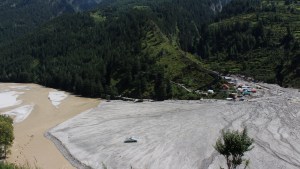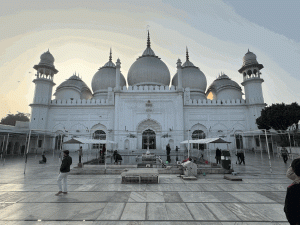


The administration of the Union Territory of Jammu and Kashmir issued an order on 9 January 2023 requesting the full removal of “all encroachment on State land, including Roshni land [land granted to the residents of the region under the Roshni Act of 2001] and Kahcharai land [common grazing land]” by 31 January.
The order directed the districts’ Deputy Commissioners (DCs) to personally monitor the anti-eviction drive and submit a daily report to the Administration Department. According to official figures, more than ten thousand hectares of land, including land regularized under the Roshni Act, were defined as under “illegal occupation.” The administration of the region claimed that only the land occupied by big vested interests would be retrieved in order to use it for public use.
Following the order, officials started a large-scale demolition drive even though many residents did not receive eviction notices before their properties were razed down.
Many shopkeepers in Keller and Nagbal, small hamlets in the remote southern district of Shopian, who received eviction notices, decided to close their businesses to protest the drive. They told us that the order was another blow to the already crumbling economy of Jammu and Kashmir. “After the scrapping of Article 370, administrative policies and back-to-back lockdowns have hurt Kashmir’s economy. The local business community is quite anxious due to the most recent order. If intimidating us is their goal, they should serve us and our families poison.”
Agitating against the order, shopkeepers in Nagbal also observed a shutdown.
“The order will leave us all unemployed. Families will starve. The market has 300 shops, all of which were constructed on state land that has been used by the locals for hundreds of years. The agency conducting anti-encroachment drives on state land and the revenue officials are visiting us every day and demanding that we remove our businesses,” a shopkeeper from Shopian’s Nagbal market told us.
“Many of us have constructed these shops with the money we made by selling our lands after apple business underwent consistent loss. Now the administration is asking us to leave. How are we going to support our families? How do we make a living?” one of them said.
The state land in Jammu and Kashmir has been historically made available to the residents through subsequent laws and reforms by successive regimes. However, the current dispensation alleges that the residents have occupied these lands and that several ‘influential’ people have grabbed kahcharai land in parts of the region.

As Dogra rule began in 1846, Maharaja Gulab Singh confiscated all private land and declared the entire Kashmir Valley to be his purchased property as peasants were stripped of land ownership rights.
In 1953, the then Prime Minister of Kashmir Sheikh Abdullah was the driving force behind the Big Landed Estate Abolition Act (1950), which gave tillers ownership of the fields they worked on as envisaged in the Naya Kashmir (New Kashmir) manifesto. The registration of tillers’ ownership rights was observed by Sheikh Abdullah personally. The Act established a maximum of 22.75 acres of surplus land to be given to the tillers without compensation.
The Jammu and Kashmir Kahcharai Act defines kahcharai land as “revenue derived or derivable from any duty, fee, tax fine or penalty imposed in relation to levy of grazing.” Kahcharai or ghaas charai is a plot of land that villagers have historically used as a common grazing ground for their livestock. In a bid to make Kashmir self-reliable, Sheikh Abdullah introduced the Grow More Food policy, promoting the collective usage of kahcharai land. Subsequently, the 1976 agrarian reforms made possible the transfer of land to tillers, “for better utilisation of land.”
In 2001, the government passed the Roshni Act with the intention of giving users of state land the ability to acquire ownership rights over a plot of land after paying a fee. However, the law was revoked in December 2018 by Satya Pal Malik, who was the governor of Jammu and Kashmir at the time, claiming that the then-ruling government had “misused” the act.
Later, in October 2020, a division bench of the Jammu and Kashmir High Court deemed the Roshni Act unconstitutional. The court said that the law was enacted “without analysis and evaluation of cost-benefit” and in an arbitrary manner as vesting several hectares of public land to private ownership makes the land unavailable for public projects and infrastructure.
Less than a month later, the Jammu and Kashmir administration issued an order that deemed null and void all the land transfers conducted under the Roshni Act. The Revenue Department was given six months to remove encroachers from the land and retrieve it.
According to the High Court order, a total of 75,575 acres of state land had been transferred under the Roshni Act – 71,401 acres in Jammu and 4,174 acres in Kashmir.
The abrogation of Article 370 paved the way for the implementation of these changes. Since 2019, when Article 370 was repealed, the new Union Territory administration extended 90 central laws and 130 state laws to Jammu and Kashmir. A further assault on the sovereignty of Kashmir came in October 2020, when the central government passed the Union Territory of Jammu and Kashmir Reorganisation (Adaptation of Central Laws) Third Order and the Jammu and Kashmir Reorganisation (Adaptation of State Laws) Fifth Order, 2020 that repealed 12 previous acts including the land reforms and amended various laws concerning the sale and purchase of land.
With these laws, for the first time, non-residents were allowed to own property in the region and the government also permitted the transfer of agricultural land for non-agricultural purposes thus transferring more than a thousand hectares of land to the Industries and Commerce Department. In 2021, a year after these Acts were passed, the administration began identifying agricultural land to be transferred to the armed forces to build camping sites. The villagers whose agricultural lands were identified for these sites staged protests against these orders.
Locals claim that the administration’s decision to transfer land to the Central Reserve Police Force will have a significant impact on over 200 families in the villages of Oukhoo and Sethargund in south Kashmir’s Pulwama district, who rely on the land for dairy farming and vegetable production.
Kashmir never witnessed an eviction drive of this scale before. As opposition grew stronger, the administration iterated that the purpose of the demolition drive was to retrieve state land encroached by “powerful and influential people.”
Several areas of Jammu including Gandhi Nagar, Bathindi, Ramban and Gujjar Nagar were also subjected to demolitions with consequent protests against the administration’s order. As the resentment grew, the Deputy Commissioners and Senior Superintendents of Police were asked “to monitor law and order situation during the drives, and to take all preventive measures in advance.” The order also directed the Additional Director General of Police (ADGPs) and Divisional Commissioners to investigate people who would make negative statements with respect to the drives “to check whether they have encroached land which they are defending.”

On 4 February 2023, protests in Jammu’s Malik Market turned violent as people pelted stones at the bulldozers sent to demolish a shopping complex. Protestors forced the operations to pause for some time, but the demolition drive later resumed after the Police dispersed the crowd with tear gas shelling. Five days after the incident, the Police arrested five people in connection with stone pelting and detained four more. Protests, however, did not stop and involved every section of society – from mainstream political factions to business communities, from farmers’ unions to local residents even in far-flung areas – because, unlike what the administration claims, a significant number of those affected by the demolition drive are from economically weaker sections of society.
The demolition drive stopped after the central government stepped in and directed the administration “to issue notices and give a proper hearing to residents before arriving with bulldozers.” An administrative official, however, claimed that it had instead been halted for “geo-tagging and geo-referencing” the retrieved land.
To put in perspective the legitimacy of the demolition drive, we talked to Professor Showkat Ahmed Sheikh, a legal expert who teaches at Kashmir’s Law College. Governments have over time enacted laws that aim at giving the right to acquire state land to occupants. “One such law is the Limitation Act, which states that if any person has been occupying a patch of land and no party is objecting to that occupation of land, under the Right by easement, nobody can evict the person occupying the land,” said Prof. Sheikh.
“An easement is a right which the owner or occupier of certain land possesses, as such, for the beneficial enjoyment of that land, to do and continue to do something, or to prevent and continue to prevent something being done, in or upon, or in respect of, certain other land not his own,” states the Indian Easements Act, 1882.
Traditionally people may not have had ownership, but they did acquire the right of possession under the Indian Easements Act, which cannot be scrapped unless occupants are served a notice and both parties could contest their claims in front of a tribunal.
According to Professor Sheikh, each case has to be monitored individually and there is no particular set of laws that may be applied overall therefore these forceful evictions are illegal as “the rights of possession cannot be scrapped at whims.”
Prof. Sheikh also said that most of these contested lands have been passed on over generations and many people are not even aware that their lands were earlier used for agricultural purposes. “During the massive food crisis, the government encouraged people throughout the country to cultivate food grains on patches of state land and now that those families have their second or their generation cultivating crops over the same patches of land, they do not know how the possession of the state land and the kahcharai land came onto them,” he said.
“In Delhi, there are around 1,200 illegal colonies, which have been legalized. The Roshni Act of Jammu and Kashmir was a step in that same direction. Now that the law is abolished, there are apprehensions that the land would be granted to outsiders,” he said.
On 7 February 2023, when demolitions were in full swing, Amnesty International demanded their immediate halt as well as compensation for those affected. “The ongoing demolitions appear to be an extension of the brutal human rights violations the region of Jammu and Kashmir, the only Muslim majority region of India, has historically witnessed,” said Aakar Patel, the Director of Amnesty International India, adding that these demolitions amount to forced evictions and constitute a gross violation of human rights.
After the administration retrieved nearly 10,000 hectares of encroached land, bulldozers have for now come to a standstill. Many families, however, are anxious about what the future holds for them. Fatima Banoo (65) lives in Shaheen Bagh colony in Srinagar, where some residents were served eviction notices urging the removal of encroachments from state property bordering the Doodh Ganga Nalla.
Fatima Banoo told us: “My husband worked as a sweeper in the municipality. He gathered money his entire life and then built this house. We have been living here for several decades, paying electricity and water bills all this while. How can our houses suddenly become illegal?”

And she added: “I have seven children. Tell me where shall I go now that I am living on state land. This is sheer oppression. Look at our houses. We do not own big plots. All we have is this small space. The government is lying when they are not harassing the poor. Since these evictions have started the poor like us are victims of intense anxiety and depression. What is this, if not injustice?”
For Fatima Banoo, like for many other poor families, these evictions put survival at stake. ”If we had a lot of money, we would have purchased a plot of land and settled down there. But we do not have money and the previous governments have been kind to us by not evicting us from here. Take a look at the surroundings and you’ll see only the poor live here in our colony. They should not harass the poor. The prayers of the poor are very powerful and it will lead to their doom,” she said.
SUPPORT US
We like bringing the stories that don’t get told to you. For that, we need your support. However small, we would appreciate it.








